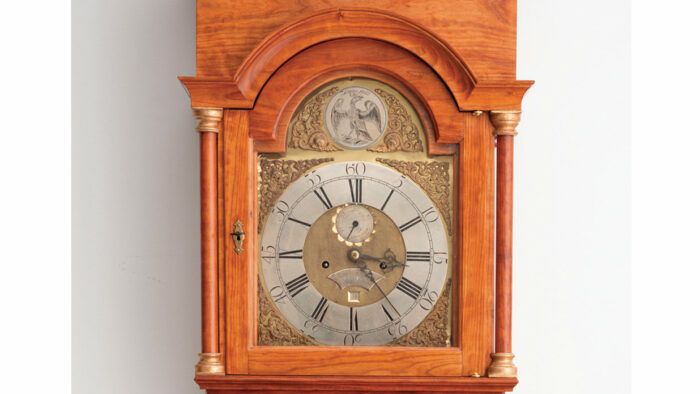From the bench: Local time
When you're a furniture maker in Concord, Mass., building a new case for a 250-year-old clock from the Revolutionary War, your thoughts have a tendency to travel back in time.
It’s 2019 in Concord, Mass. As I work, I wonder what I’ve gotten myself into—agreeing to build a reproduction clock case for the Concord Museum. The simple rectangular box that forms the basic case has the same form as the Shaker furniture that I build as a hobby. But how was I going to handle the not-so-linear forms of the 11 different molding profiles—some straight, others on radii—that turn that basic box into an 80-in.-high clock case? How was I going to deliver the simple beauty of the original, created 250 years ago by Nathaniel Mulliken, just six miles away?
1769, Lexington, Mass. Nathaniel has been running his family’s clockmaking business since his father died in 1767. Down the hill from his shop on the town green sits John Buckman’s Tavern, first licensed in 1693. Nathaniel delivers an 8-day case clock that John had ordered. The face is inscribed with Buckman’s name, Mulliken’s name, the year, and a reminder: Tempus Fugit (“time flies”).
1775, Lexington, Mass. John Adams and John Hancock have fled to Lexington from Boston as the British occupation is about to boil over. Paul Revere and William Dawes ride into town just after midnight on April 19 with news of the British march. The town’s small militia, including Nathaniel, assembles on the green. Some head to Buckman’s, where the clock measures out the hours until the British column arrives at dawn. Eight Americans die in the short fight. A few hours later, the British burn buildings—including Mulliken’s house and shop—as they retreat from Concord.
250 years later
The Concord Museum has owned the Buckman clock since the 1970s. The movement and its face are in fine condition, mounted on the original rough 1-in. pine base. But the case has been lost. David Wood, curator of the museum, asks me if I’d be willing to build a reproduction case for this tavern clock.
Since no barroom I’d ever been in had a “grandfather clock,” I assume this is a small clock—perhaps for a mantel. I say yes on the spot; how hard could it be? A local collector owns a sister clock and graciously invites me to photograph and measure. David joins me; I don’t think he catches my surprise when I see the case, which is taller than I am, with a complex sarcophagus top, two doors, three windows, lots of curves, and 10 turned pieces. I make measured drawings of everything.
Over the next 18 months, I build the clock case, a tribute to a local craftsman who died young in our revolution. And the case builds my skills as a reproduction craftsman.
What the clock taught me
Push yourself. I wish I’d done a piece this complex 20 years ago. It taught me new techniques; mostly it taught me that my basic skills scale up easily.
Leave a mark behind. The case I measured had a small triangle inscribed in the pine secondary wood on the top of the sarcophagus. I found a batten from a 200-year old barn door with a similar scratching and used it for my top. Nobody will see it, but I know it is there.
The original isn’t perfect; yours doesn’t need to be either. I made mistakes. I corrected most, but a handful remain. I found at least that many in the case that I copied; they make the piece authentic.
Understand the variation in the originator’s work. David Wood took the time to show me many examples of Mulliken’s cases. The differences of design, construction techniques, and workmanship, even across a single maker, is remarkable. Knowing that range gives you confidence to make design variations that are authentic.
A reproduction doesn’t need to be an exact copy. Instead of mahogany or walnut, I used cherry, a wood whose behavior I know and love. I happily used brass screws instead of nails and glue in the hidden joints.
Enjoy the hand tools. I do not have the skill to use only hand tools to build the case. But the time I spent with hand tools (probably 2⁄3 of the hours) was the most satisfying. And quietest; time to reflect on the life of a local craftsman working by candlelight in 1769 with tools not much different from mine.
Tempus fugit
Mulliken died early in the war. His widowed mother rebuilt their house, which still stands. Buckman Tavern still overlooks the Lexington Green. It is a museum and historical society, complete with a musket ball hole from April 19 in the front door. It is worth a visit. Mulliken’s Buckman clock is in the permanent April 19th exhibit of the Concord Museum. It sounds magnificent and it keeps fine time. □
Bill Huyett is a furniture maker in Concord, Mass.
Photos: William Huyett
More like this
 |
Copying Museum Pieces |
 |
Furniture Student Builds Reproduction of Emily Dickinson’s Bureau |
 |
From the archive: Shaker-Style Clock |
Fine Woodworking Recommended Products

Circle Guide

Drafting Tools

Dividers






















Log in or create an account to post a comment.
Sign up Log in